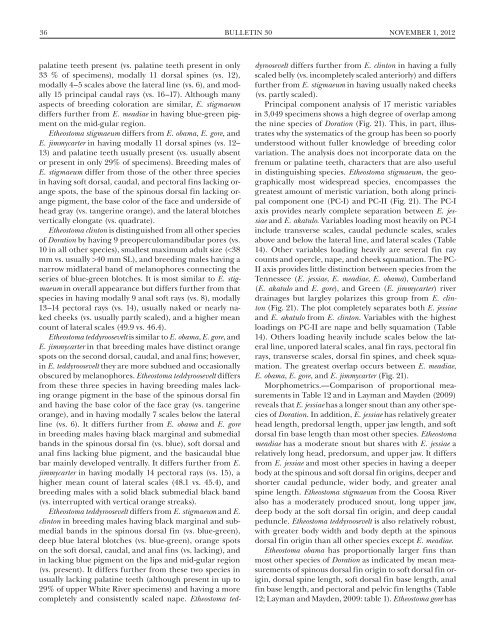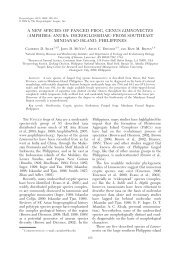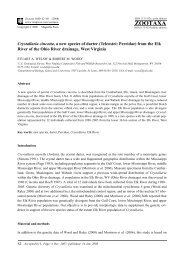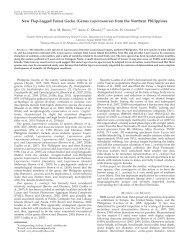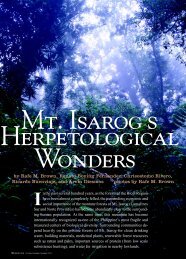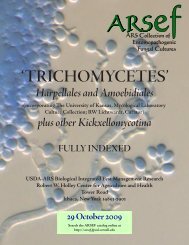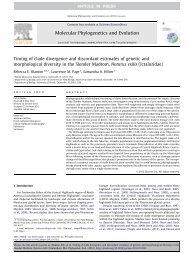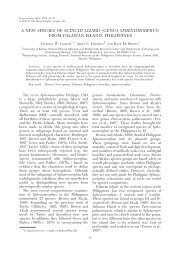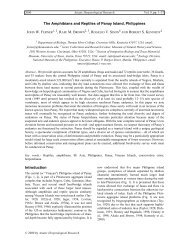(Percidae: Etheostoma), with Descriptions of Five New Species
(Percidae: Etheostoma), with Descriptions of Five New Species
(Percidae: Etheostoma), with Descriptions of Five New Species
- No tags were found...
You also want an ePaper? Increase the reach of your titles
YUMPU automatically turns print PDFs into web optimized ePapers that Google loves.
36 Bulletin 30 NOVEMBER 1, 2012palatine teeth present (vs. palatine teeth present in only33 % <strong>of</strong> specimens), modally 11 dorsal spines (vs. 12),modally 4–5 scales above the lateral line (vs. 6), and modally15 principal caudal rays (vs. 16–17). Although manyaspects <strong>of</strong> breeding coloration are similar, E. stigmaeumdiffers further from E. meadiae in having blue-green pigmenton the mid-gular region.<strong>Etheostoma</strong> stigmaeum differs from E. obama, E. gore, andE. jimmycarter in having modally 11 dorsal spines (vs. 12–13) and palatine teeth usually present (vs. usually absentor present in only 29% <strong>of</strong> specimens). Breeding males <strong>of</strong>E. stigmaeum differ from those <strong>of</strong> the other three speciesin having s<strong>of</strong>t dorsal, caudal, and pectoral fins lacking orangespots, the base <strong>of</strong> the spinous dorsal fin lacking orangepigment, the base color <strong>of</strong> the face and underside <strong>of</strong>head gray (vs. tangerine orange), and the lateral blotchesvertically elongate (vs. quadrate).<strong>Etheostoma</strong> clinton is distinguished from all other species<strong>of</strong> Doration by having 9 preoperculomandibular pores (vs.10 in all other species), smallest maximum adult size (40 mm SL), and breeding males having anarrow midlateral band <strong>of</strong> melanophores connecting theseries <strong>of</strong> blue-green blotches. It is most similar to E. stigmaeumin overall appearance but differs further from thatspecies in having modally 9 anal s<strong>of</strong>t rays (vs. 8), modally13–14 pectoral rays (vs. 14), usually naked or nearly nakedcheeks (vs. usually partly scaled), and a higher meancount <strong>of</strong> lateral scales (49.9 vs. 46.4).<strong>Etheostoma</strong> teddyroosevelt is similar to E. obama, E. gore, andE. jimmycarter in that breeding males have distinct orangespots on the second dorsal, caudal, and anal fins; however,in E. teddyroosevelt they are more subdued and occasionallyobscured by melanophores. <strong>Etheostoma</strong> teddyroosevelt differsfrom these three species in having breeding males lackingorange pigment in the base <strong>of</strong> the spinous dorsal finand having the base color <strong>of</strong> the face gray (vs. tangerineorange), and in having modally 7 scales below the lateralline (vs. 6). It differs further from E. obama and E. gorein breeding males having black marginal and submedialbands in the spinous dorsal fin (vs. blue), s<strong>of</strong>t dorsal andanal fins lacking blue pigment, and the basicaudal bluebar mainly developed ventrally. It differs further from E.jimmycarter in having modally 14 pectoral rays (vs. 15), ahigher mean count <strong>of</strong> lateral scales (48.1 vs. 45.4), andbreeding males <strong>with</strong> a solid black submedial black band(vs. interrupted <strong>with</strong> vertical orange streaks).<strong>Etheostoma</strong> teddyroosevelt differs from E. stigmaeum and E.clinton in breeding males having black marginal and submedialbands in the spinous dorsal fin (vs. blue-green),deep blue lateral blotches (vs. blue-green), orange spotson the s<strong>of</strong>t dorsal, caudal, and anal fins (vs. lacking), andin lacking blue pigment on the lips and mid-gular region(vs. present). It differs further from these two species inusually lacking palatine teeth (although present in up to29% <strong>of</strong> upper White River specimens) and having a morecompletely and consistently scaled nape. <strong>Etheostoma</strong> teddyrooseveltdiffers further from E. clinton in having a fullyscaled belly (vs. incompletely scaled anteriorly) and differsfurther from E. stigmaeum in having usually naked cheeks(vs. partly scaled).Principal component analysis <strong>of</strong> 17 meristic variablesin 3,049 specimens shows a high degree <strong>of</strong> overlap amongthe nine species <strong>of</strong> Doration (Fig. 21). This, in part, illustrateswhy the systematics <strong>of</strong> the group has been so poorlyunderstood <strong>with</strong>out fuller knowledge <strong>of</strong> breeding colorvariation. The analysis does not incorporate data on thefrenum or palatine teeth, characters that are also usefulin distinguishing species. <strong>Etheostoma</strong> stigmaeum, the geographicallymost widespread species, encompasses thegreatest amount <strong>of</strong> meristic variation, both along principalcomponent one (PC-I) and PC-II (Fig. 21). The PC-Iaxis provides nearly complete separation between E. jessiaeand E. akatulo. Variables loading most heavily on PC-Iinclude transverse scales, caudal peduncle scales, scalesabove and below the lateral line, and lateral scales (Table14). Other variables loading heavily are several fin raycounts and opercle, nape, and cheek squamation. The PC-II axis provides little distinction between species from theTennessee (E. jessiae, E. meadiae, E. obama), Cumberland(E. akatulo and E. gore), and Green (E. jimmycarter) riverdrainages but largley polarizes this group from E. clinton(Fig. 21). The plot completely separates both E. jessiaeand E. akatulo from E. clinton. Variables <strong>with</strong> the highestloadings on PC-II are nape and belly squamation (Table14). Others loading heavily include scales below the lateralline, unpored lateral scales, anal fin rays, pectoral finrays, transverse scales, dorsal fin spines, and cheek squamation.The greatest overlap occurs between E. meadiae,E. obama, E. gore, and E. jimmycarter (Fig. 21).Morphometrics.—Comparison <strong>of</strong> proportional measurementsin Table 12 and in Layman and Mayden (2009)reveals that E. jessiae has a longer snout than any other species<strong>of</strong> Doration. In addition, E. jessiae has relatively greaterhead length, predorsal length, upper jaw length, and s<strong>of</strong>tdorsal fin base length than most other species. <strong>Etheostoma</strong>meadiae has a moderate snout but shares <strong>with</strong> E. jessiae arelatively long head, predorsum, and upper jaw. It differsfrom E. jessiae and most other species in having a deeperbody at the spinous and s<strong>of</strong>t dorsal fin origins, deeper andshorter caudal peduncle, wider body, and greater analspine length. <strong>Etheostoma</strong> stigmaeum from the Coosa Riveralso has a moderately produced snout, long upper jaw,deep body at the s<strong>of</strong>t dorsal fin origin, and deep caudalpeduncle. <strong>Etheostoma</strong> teddyroosevelt is also relatively robust,<strong>with</strong> greater body width and body depth at the spinousdorsal fin origin than all other species except E. meadiae.<strong>Etheostoma</strong> obama has proportionally larger fins thanmost other species <strong>of</strong> Doration as indicated by mean measurements<strong>of</strong> spinous dorsal fin origin to s<strong>of</strong>t dorsal fin origin,dorsal spine length, s<strong>of</strong>t dorsal fin base length, analfin base length, and pectoral and pelvic fin lengths (Table12; Layman and Mayden, 2009: table 1). <strong>Etheostoma</strong> gore has


